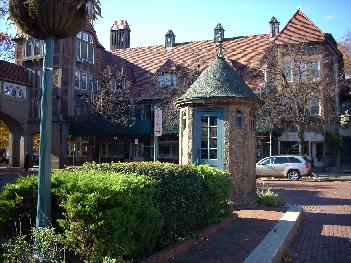SITE GUIDE
SEARCH
REVIEWS
REVIEW ARCHIVES
ADVERTISING AT CURTAINUP
FEATURES
NEWS
Etcetera and
Short Term Listings
LISTINGS
Broadway
Off-Broadway
NYC Restaurants
BOOKS and CDs
OTHER PLACES
Berkshires
London
California
New Jersey
DC
Philadelphia
Elsewhere
QUOTES
TKTS
PLAYWRIGHTS' ALBUMS
LETTERS TO EDITOR
FILM
LINKS
MISCELLANEOUS
Free Updates
Masthead
Writing for Us
A CurtainUp Review
Queens Boulevard
With Additional Thoughts by Elyse Sommer
|
Vijay? Where were you? — Shizuko I went to get the flower of heaven for you — Vijay |

Amir Arison and Michi Barall
(Photo: Carol Rosegg) |
So while we wait patiently for someone to discover the dramatic potential of the Grand Concourse, let's be open and warmly receptive to Charles Mee's charming music-enhanced embrace of Queens Boulevard. Notwithstanding Mee's previous obsession with the many facets of love that include Big Love, True Love, First Love, Summertime and Wintertime, his apparent infatuation with theater as a toy is as commendable as it is unfettered by convention. With Queens Boulevard, one gets the feeling that Mee prefers to envision a completely theatrical world that resonates with both classical textures and contemporary attitudes, a conceit that he used to stunning effect in the recent production of Iphigenia 2.0, also at the Signature Theater.
Mee has used the Katha-Kali play The Flower of Good Fortune by Kottayan Tampuran (a dramatization of the classical Indian story of Shakuntala) as his inspiration with credit given to Tom Damrauer for dramaturgical assistance. Not knowing the play, I must assume from the story and the action that Mee was enamored by what is essentially a fable with a moral that contends that true love may be compromised by distractions and digressions but never destroyed. The program also notes that the text incorporates selected bits from Homer, James Joyce, Ono No Komachi, Usun Kwon, Valerie Solanus, Dolat H. Doongaji and A.K. Lavangia as well as blogs from the neighborhoods of Queens.
In addition to Mee's inclination to "sample," for his text, he also includes a mixture of amusing musical divertissements. These augment the borough-wide journey of Vijay (played with a winning naiveté by Amir Arison), a young groom of Indian descent, as he goes on a quest soon after their wedding vows to find the flower of good fortune as a gift for his bride of Chinese descent Shizuko (played with a winsome spirit by Michi Barall).
The audience is invited to participate, as either members of the groom's or the bride's family by the wedding DJ (played with the prescribed exuberance by Satya Bhabha). The celebrants of both families and their friends, however, are already mingling and dancing as the audience enters the completely transformed interior of the Peter Norton Space. Jello-O shots are handed out and a photo is taken of the couple in the audience who had been married the longest. One couple admitted to 63 years together.
You would have to be blind not to be impressed by the dazzling and almost dizzying evocation of a compacted shopping arcade on Queens Boulevard, as created by set designer Mimi Lien. The neon signs are ablaze over a cluster of stores that include a barber shop, a nail salon, music store, travel agency, vegetable and flower market.
Although Asian and middle eastern influences punctuate the dances created by Peter Pucci, there is a decided taste for Bollywood in the air as well as karaoke and video streaming. Also embedded is a potpourri of songs from Shoukichi Kina, Anu Malik & Craig Pruess, ABBA and others, as well as traditional Okinawan, Iranian and Irish folk songs to define not only the neighborhood but also various ethnicities of the principal characters. Fourteen performers, in a wash of colorful costumes by Christal Weatherly, play more than thirty-five characters. All are inclined to play their roles with broad but infectious flourishes.
The plot (shades of Homer's The Odyssey), under the watchful eye of director Davis McCallum, progresses episodically as a series of comical diversions and digressions, most of which are inserted for their ability to delight us without being particularly deep or meaningful. Arian Moayed is excellent as Abdi, the friend who initially leads Vijay astray. A trip to the Russian baths allows the male performers to do a bit of naughty towel dancing that for the record is funnier than anything in The Ritz. Shizuko also gets lured out of the house and into a bit of frisky night club hopping by her girl friends.
A favorite moment: Ruth Zhang, as Shizuko's mother, singing "Dancing Queen" in full throttle coloratura. Emilie Donahoe is seductive as Colleen, Vijay's old flame and Debargo Sanyal, earns laughs as a push cart entrepreneur whose business talents includes palmistry, massage, dentistry and a knack for fast talk. Speaking of talk, the text is deployed with a pretentiousness that presumes that no one is going to take this facetiously whimsical excursion to Queen Boulevard seriously. And that is as it should be.


